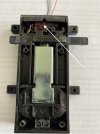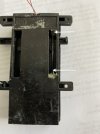Airbuspilot
Registered
This layout was started before I came along so I am in discovery mode, yesterday I found couple of motors which had been modified to include the decoder inside the box.
The decoder is at the opposite end to the terminal block, it requires small holes drilled to pass the motor wires through the slots under the unit and then connected to the existing terminal block. Another small hole drilled to allow the two wires to the track.
Im not sure if this is better or worse, it's an alternative, it does require additional water proofing.
Robin


The decoder is at the opposite end to the terminal block, it requires small holes drilled to pass the motor wires through the slots under the unit and then connected to the existing terminal block. Another small hole drilled to allow the two wires to the track.
Im not sure if this is better or worse, it's an alternative, it does require additional water proofing.
Robin


